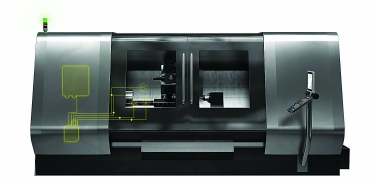Last year, Sandvik Coromant Co. introduced its CoroPlus Collision Detector, which is designed to effectively use data to minimize damage to both a machine tool and a workpiece in the event of a crash. The system is connected to the machine tool’s PLC and can detect and react to a collision within 5 milliseconds, according to the company. It shuts down the spindle and axes drivers, reducing downtime and workpiece costs while reportedly maintaining consistent part quality.
The detector can be used in a variety of operations, including turning, milling and drilling, and on new or used equipment. It represents the latest development in monitoring individual machines.

CoroPlus Collision Detector collects and uses data to minimize damage to both a machine tool and a workpiece in the event of a crash. Image courtesy of Sandvik Coromant.
Sandvik Coromant now is looking to move to the next level. According to Adir Zonta, product manager of process monitoring and machining analytics, the next stage is to connect machines so they can be monitored by parties other than just their operators. Updates to software and algorithms could then be delivered via the cloud or a company network.
Benefits of this connectivity “include reducing unplanned downtime caused by unexpected collisions, minimizing tooling and repair costs by monitoring tool overload or tool breakage, and cutting idle machine time caused by missing tools,” Zonta said.
One obstacle to reaching the next levels of productivity, security and quality is the lack of standardization among various technologies, including different devices, the cloud and numerous kinds of software. Improved connectivity will require greater standardization.
Sandvik Coromant’s long-term goals are ambitious. The company believes that in time its machine learning process could increase metal-removal efficiency from the 80 percent level available with conventional machines to as much as 95 percent. “Machine process monitoring can be the catalyst for significant change in the manufacturing industry,” Zonta concluded.
For more information about Fair Lawn, N.J.-based Sandvik Coromant Co.’s CoroPlus Collision Detector, visit www.sandvik.coromant.com/us or call (800) SANDVIK.
Related Glossary Terms
- gang cutting ( milling)
gang cutting ( milling)
Machining with several cutters mounted on a single arbor, generally for simultaneous cutting.
- milling
milling
Machining operation in which metal or other material is removed by applying power to a rotating cutter. In vertical milling, the cutting tool is mounted vertically on the spindle. In horizontal milling, the cutting tool is mounted horizontally, either directly on the spindle or on an arbor. Horizontal milling is further broken down into conventional milling, where the cutter rotates opposite the direction of feed, or “up” into the workpiece; and climb milling, where the cutter rotates in the direction of feed, or “down” into the workpiece. Milling operations include plane or surface milling, endmilling, facemilling, angle milling, form milling and profiling.
- turning
turning
Workpiece is held in a chuck, mounted on a face plate or secured between centers and rotated while a cutting tool, normally a single-point tool, is fed into it along its periphery or across its end or face. Takes the form of straight turning (cutting along the periphery of the workpiece); taper turning (creating a taper); step turning (turning different-size diameters on the same work); chamfering (beveling an edge or shoulder); facing (cutting on an end); turning threads (usually external but can be internal); roughing (high-volume metal removal); and finishing (final light cuts). Performed on lathes, turning centers, chucking machines, automatic screw machines and similar machines.









